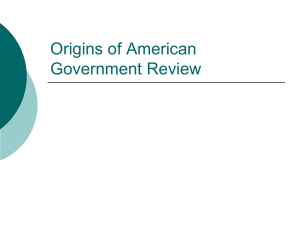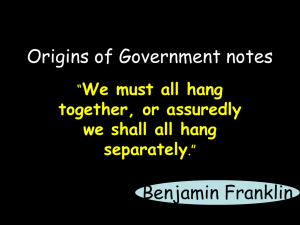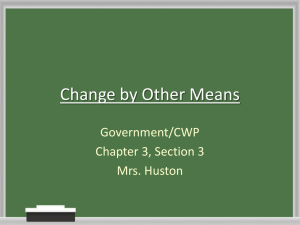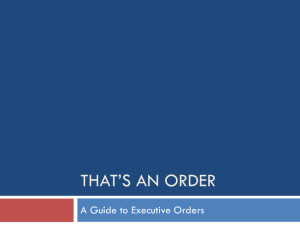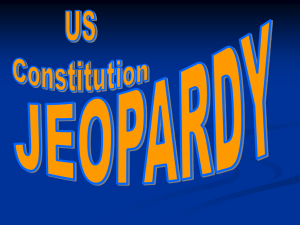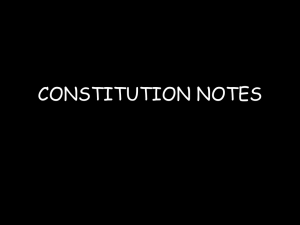Powerpoint AOC
advertisement
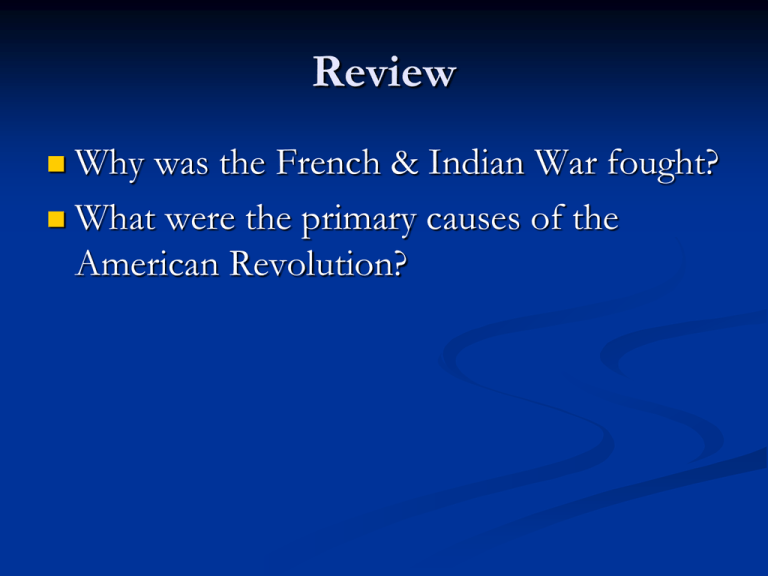
Review Why was the French & Indian War fought? What were the primary causes of the American Revolution? What were the colonial responses to British actions such as the Proclamation Act of 1763, Stamp Act, & Intolerable Acts? What was the importance of Thomas Paine’s Common Sense? Standards USHC-1.4 Analyze how dissatisfactions with the government under the Articles of Confederation were addressed with the writing of the Constitution of 1787, including the debates and compromises reached at the Philadelphia Convention and the ratification of the Constitution. SHAPING A NEW NATION Articles of Confederation and Constitution Forming a Republic Following the Revolutionary War, the Second Continental Congress met to form a government. However, the states were reluctant to unite under a strong central government. Most people’s allegiance was to the state, not the national government The delegates believed a democracy placed too much power in the hands of uneducated masses, so they favored a Republic – where citizens rule through elected representatives. Drafting a National Constitution The members of the Second Continental Congress had to answer three main questions: Representation by population or state? Can Supreme Power be divided? Who gets the Western Lands? They answered these questions by drafting the Articles of Confederation - 1781 Articles of Confederation a “firm league of friendship” The Articles of Confederation was formed and became the 1st official government of the U.S. The state governments would hold supreme power in most cases granting power to the national govt. in limited situations. Representation determined by state, not population. Therefore each state allowed was allowed ONE vote!! Articles of Confederation Strengths of Articles of Confederation: -Land Ordinance of 1785- a system of surveying land -The Northwest Land Ordinance of 1787 –provided a system of dividing western territories and set requirements for the admission of new states P. 138 Weaknesses of Articles of Confederation 1. 2. 3. 4. 5. 6. 7. Weak national government Nat’l govt. could not tax (weak economy) No executive branch to enforce laws No Judicial branch to interpret laws States controlled trade Articles could not be amended without consent of every state Unfair Representation (1 state = 1 vote) Role of executive “The United States in Congress assembled shall have authority … to appoint such other committees and civil officers as may be necessary for managing the general affairs of the United States under their direction -- to appoint one of their members to preside, provided that no person be allowed to serve in the office of president more than one year in any term of three years;” Shays’s Rebellion (proves the Articles are too weak) (pg. 140) 1786-87 Daniel Shays and a group of 1200 angry farmers tried to revolt against the government over unfair taxes. (they were farmers who were going to lose their farms to creditors for not being able to pay the high taxes to the state) The Rebellion showed the danger of the weak national government not having the power to stop a rebellion. Shays’ Rebellion (1786) became a concern for many national leaders because it: (a) indicated there would be future conflicts over the spread of slavery (b) exposed fundamental weaknesses in government under the Articles of Confederation (c) pointed to the need for federal government regulation of interstate commerce (d) showed that frontier settlements were vulnerable to raids by Native American Indians Review Question The Articles of Confederation proved ineffective as a national body of laws for which of the following reasons? A. It gave too much power to the Congress without providing for a commander of the nation’s armed forces B. It did not give the federal government enough power to effectively lead C. It imposed taxes that led to a rebellion of farmers in New England D. It prevented individual states from having their own constitutions In response, the delegates called a meeting (in Philadelphia 1787) to amend the Articles of Confederation. At the meeting they rejected it all together and began writing the Constitution. THE CONSTITUTION 1. 2. 3. James Madison – “Father of the Constitution.” The main disputes were: Over Representation (large states vs. small states) North vs. South over slavery Division of powers James Madison Father of the Constitution Fight Over Representation Virginia Plan (Favored large states) 1. 3 Separate Branches 2. Bicameral Congress (2 houses) 3. **Representation based on Population 4. Congress would legislate (make laws) 5. Executive Branch (1 person) New Jersey Plan (Favored small states) 1. 2. 3. 4. Unicameral Congress (1 house) **Equal Representation Exec. Branch with more than one person Limit Congressional Power Great Compromise- (The Connecticut Compromise) 1. 2. Bicameral Congress – 2 houses Representation: Senate – Equal Representation House of Rep. – Based on the population of the state Executive branch would consist of one person North vs. South over Slavery 1. 2. Three-Fifths (3/5) Compromise – all Free people would be counted in the population and 3/5 of all other persons would be counted Commerce and Slave trade – Congress regulates trade, but would not interfere with the slave trade for 20 years. FEDERALISM Delegates create a Federalist form of government with three branches Federalism – power divided between national and state governments ENUMERATED or DELEGATED POWERS Powers granted to the National Government by the Constitution These powers include: Control of Foreign Affairs Providing National Defense Regulating trade between states Coining money RESERVED POWERS Powers kept by the state. These powers include: Providing and supervising education Establishing marriage laws Regulating trade within a state CONCURRENT OR SHARED POWERS Both levels of government share such powers as: The right to tax Right to borrow money and pay debts Power to establish courts Division of Government Powers 1. 2. 3. Separation of Powers - 3 Branches of Government (each having powers the others do not) Legislative Branch – Makes the laws. Executive Branch – Carries out and enforces the laws. Judicial Branch – Interprets the laws. Checks and Balances – A system established by the delegates to prevent one branch from dominating the others. Electoral College – chosen by the state - officially elects the Pres. Checks and Balances Examples: – President has the power of veto but Congress can override – Supreme Court declare laws of Congress unconstitutional -President appoints federal judges with approval of Congress -S. Court can declare executive orders unconstitutional -Congress can refuse judicial appointments -Senate can refuse to ratify a foreign treaty Ratification of the Constitution Ratification – official approval (required 9 of the 13 states) Federalists – supporters of the Constitution (favored a strong central govt.) Examples: George Washington, James Madison, Alexander Hamilton Anti-federalists – those that opposed the Constitution (believed a central govt. would be too powerful and take rights away from the people) Wanted a BILL OF RIGHTS Examples: Patrick Henry, Samuel Adams, T. Jefferson Ratification The Federalist Papers– a series of essays defending the Constitution The Antifederalists also published essays demanding the Constitution include a Bill Of Rights protecting the rights of the people The Federalists promised to add a Bill Of Rights which led to the states ratification of the Constitution FEDERALIST ANTI-FEDERALISTS Bill of Rights (page 166) st 1 Amendment Freedom of religion Freedom of speech Freedom of the press Freedom of assembly Right of the people to petition the government nd 2 Amendment Right to bear arms rd 3 Amendment Quartering troops th 4 Amendment Search seizure and th 5 Amendment Rights of accused persons th 6 Amendment Right to a speedy, public trial th 7 Amendment Trial by jury in civil cases th 8 Amendment No excessive bail or fines No cruel or unusual punishments th 9 Amendment Rights people of the th 10 Amendment Powers of states and people
